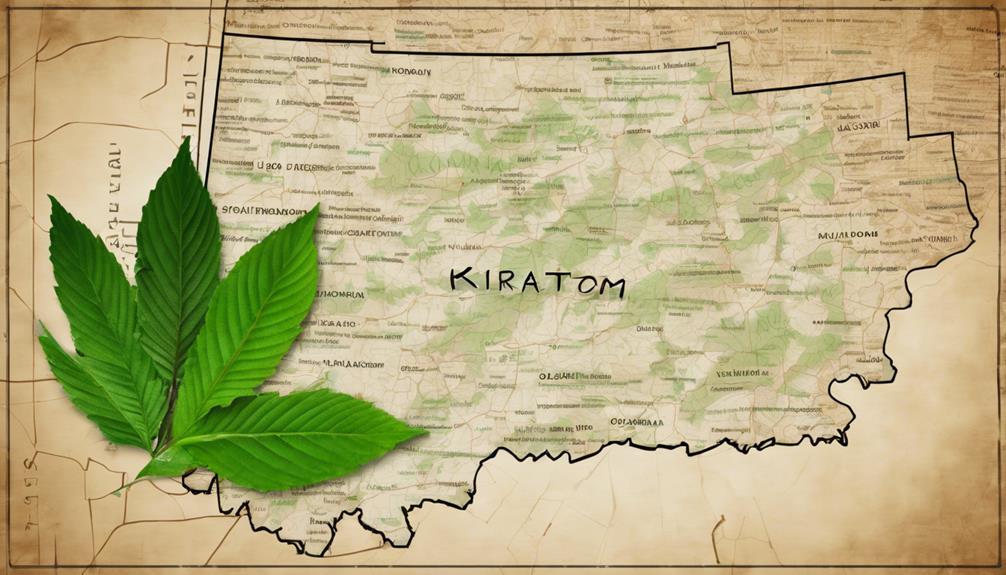Deprecated: mb_convert_encoding(): Handling HTML entities via mbstring is deprecated; use htmlspecialchars, htmlentities, or mb_encode_numericentity/mb_decode_numericentity instead in /home/users/kratomfiles/www/kratomfiles.com/wp-content/plugins/quick-adsense-reloaded/includes/template-functions.php on line 3552
Kratom, also known as Mitragyna speciosa, is a tropical evergreen tree in the coffee family native to Southeast Asia. It has been used for centuries in traditional medicine to alleviate pain, boost energy, and relieve anxiety. The leaves of the kratom tree contain compounds called alkaloids, including mitragynine and 7-hydroxymitragynine, which interact with opioid receptors in the brain to produce a range of effects. Kratom is typically consumed by chewing the leaves, brewing them into a tea, or grinding them into a powder that can be mixed with water or other liquids. In recent years, kratom has gained popularity in the United States as an herbal supplement, with proponents touting its potential benefits for managing chronic pain, opioid withdrawal symptoms, and mood disorders.
Despite its traditional use and growing popularity, kratom has also been the subject of controversy and regulatory scrutiny due to concerns about its safety and potential for abuse. The legal status of kratom varies from state to state, with some jurisdictions imposing restrictions or outright bans on its sale and possession. In Indiana, kratom has been the focus of legislative and regulatory efforts aimed at addressing these concerns and determining its future status in the state.
Key Takeaways
- Kratom is a tropical tree native to Southeast Asia, known for its leaves that have psychotropic effects when consumed.
- Kratom has a long history of traditional use in its native regions for its stimulant and opioid-like effects.
- Kratom is currently legal in Indiana, but there have been efforts to regulate or ban its sale and use in the state.
- Public perception of kratom in Indiana is mixed, with some advocating for its benefits and others expressing concerns about its potential risks.
- Health and safety concerns related to kratom in Indiana include potential for addiction, adverse effects on mental health, and the risk of contamination in unregulated products.
History of Kratom in Indiana
The history of kratom in Indiana is marked by a series of legal and regulatory developments that have shaped its current status in the state. In 2014, the Indiana General Assembly passed a bill that classified kratom as a synthetic drug and added it to the list of controlled substances, effectively making its sale and possession illegal in the state. This move was prompted by concerns about the potential for abuse and addiction associated with kratom, as well as reports of adverse effects and even deaths linked to its use.
However, in 2016, following public outcry and advocacy efforts by kratom supporters, the Indiana legislature reversed course and removed kratom from the list of controlled substances. This decision effectively legalized kratom in the state, allowing for its sale and possession under certain regulations. Specifically, the law stipulated that kratom products must be labeled with a warning about potential side effects and not be sold to individuals under 18 years of age. This change reflected a shift in the perception of kratom and recognition of its potential benefits, leading to a period of relative stability for its availability and use in Indiana.
Current Legal Status of Kratom in Indiana
As of the present day, kratom remains legal in Indiana for individuals over 18 years of age. However, there are ongoing discussions and legislative efforts that could potentially impact its status in the state. While kratom is not classified as a controlled substance, it is subject to regulations governing its sale and labeling. Retailers are required to adhere to these regulations to ensure compliance with state law and protect consumers from potential harm.
The current legal status of kratom in Indiana reflects a delicate balance between acknowledging its traditional uses and potential benefits while also addressing concerns about safety and regulation. This balance is reflected in the efforts to establish guidelines for responsible use and distribution of kratom products, as well as ongoing discussions about potential changes to existing regulations. As such, the legal landscape surrounding kratom in Indiana remains dynamic and subject to potential shifts in response to evolving public perception and emerging evidence about its effects.
Efforts to Regulate or Ban Kratom in Indiana
| Date | Regulation/Ban Effort | Status |
|---|---|---|
| 2014 | Introduced bill to ban kratom | Failed |
| 2016 | Introduced bill to regulate kratom as a controlled substance | Failed |
| 2017 | Introduced bill to regulate kratom as a controlled substance | Failed |
| 2019 | Introduced bill to regulate kratom as a controlled substance | Failed |
| 2020 | Introduced bill to regulate kratom as a controlled substance | Failed |
Despite its current legal status, kratom has continued to be the subject of regulatory scrutiny and efforts to impose restrictions on its sale and use in Indiana. In recent years, there have been proposed bills in the Indiana General Assembly that sought to ban or regulate kratom due to concerns about its potential for abuse and adverse effects. These efforts have been driven by a range of factors, including reports of kratom-related hospitalizations and deaths, as well as broader concerns about the unregulated nature of the kratom market.
Proponents of these measures argue that stricter regulations or bans are necessary to protect public health and safety, particularly in light of the opioid crisis and concerns about substance abuse. They point to evidence suggesting that kratom can have addictive properties and pose risks when used in combination with other substances. On the other hand, advocates for kratom emphasize its potential benefits for individuals seeking alternative treatments for pain management and opioid withdrawal, as well as its cultural significance in traditional medicine.
The debate over efforts to regulate or ban kratom in Indiana reflects broader tensions surrounding the appropriate balance between access to herbal supplements and public health concerns. As such, it remains a topic of ongoing discussion and legislative action that will continue to shape the future outlook for kratom in the state.
Public Perception and Use of Kratom in Indiana
The public perception and use of kratom in Indiana are influenced by a range of factors, including cultural attitudes, media coverage, and personal experiences. While some individuals view kratom as a natural remedy with potential health benefits, others are wary of its safety and potential for abuse. Public awareness of kratom has grown in recent years due to increased media coverage and advocacy efforts by both proponents and critics.
In terms of use, kratom has gained a following among individuals seeking alternative treatments for chronic pain, opioid withdrawal symptoms, and mood disorders. Some users report positive experiences with kratom, citing its ability to alleviate symptoms and improve their quality of life. However, there are also reports of adverse effects and addiction associated with long-term or excessive use of kratom, raising concerns about its safety and potential for misuse.
Overall, the public perception and use of kratom in Indiana reflect a complex interplay of individual experiences, cultural attitudes, and regulatory considerations. As such, it remains a topic of ongoing discussion and debate that will continue to shape attitudes towards kratom and its place in the state.
What is the current legal status of Kratom in Indiana?
The kratom legality in Indiana is currently uncertain. In 2014, the state banned the sale of kratom, but the ban was lifted in 2019. However, there are still some restrictions, and the situation is constantly evolving. It’s important to stay updated on the current laws and regulations regarding kratom in Indiana.
Potential Health and Safety Concerns Related to Kratom

The potential health and safety concerns related to kratom have been a focal point of discussions surrounding its legal status and regulation in Indiana. While proponents tout its potential benefits for managing pain and opioid withdrawal symptoms, critics raise concerns about its addictive properties and potential for adverse effects. These concerns are informed by a range of factors, including scientific research, clinical reports, and public health considerations.
One key concern is the potential for addiction associated with long-term or excessive use of kratom. Some studies have suggested that regular use of kratom can lead to physical dependence and withdrawal symptoms when usage is discontinued. Additionally, there have been reports of individuals experiencing adverse effects such as nausea, vomiting, seizures, and even deaths linked to kratom use. These reports have raised questions about the safety of kratom and underscored the need for responsible use and regulation.
In light of these concerns, there have been calls for more research into the effects of kratom on human health and well-being. Proponents argue that a better understanding of its pharmacological properties and potential benefits could inform more nuanced approaches to regulation and harm reduction. As such, ongoing efforts to address potential health and safety concerns related to kratom will continue to shape its future outlook in Indiana.
Future Outlook for Kratom in Indiana
The future outlook for kratom in Indiana is shaped by a range of factors, including legislative developments, public perception, scientific research, and regulatory considerations. The ongoing discussions surrounding its legal status reflect broader tensions between acknowledging its traditional uses and addressing concerns about safety and regulation. As such, the future outlook for kratom in Indiana remains dynamic and subject to potential shifts in response to evolving evidence and public discourse.
One key factor that will likely influence the future outlook for kratom is ongoing research into its pharmacological properties and potential benefits. A better understanding of how kratom interacts with the body could inform more nuanced approaches to regulation and harm reduction. Additionally, public perception and advocacy efforts will continue to play a role in shaping attitudes towards kratom and influencing legislative action.
Overall, the future outlook for kratom in Indiana is characterized by uncertainty and ongoing debate. The complex interplay of cultural attitudes, scientific evidence, and regulatory considerations will continue to shape its status in the state. As such, it remains a topic of ongoing discussion that will require careful consideration of diverse perspectives and evidence-based approaches to ensure public health and safety.
If you’re interested in learning more about the potential benefits of kratom as an alternative to traditional medications, you may want to check out this article. It discusses how some people have turned to kratom to manage pain, anxiety, and other health issues. Additionally, if you’re curious about the popularity of kratom shots, you can read about it in this article.










